Overview
Classified as a
UNESCO World Heritage Site in 1995, Luang Prabang resides by the sacred confluence of the Khan and Mekong rivers. Temples and monasteries dominate any visitor’s itinerary here, with its 33 gilded wats and numerous saffron clad monks.
Having received a rush of investment since the 1990’s, once dilapidated French villas have been reimagined as stunning but affordable boutique hotels and hostels. Many of these villas stand today due to Luang Prabang being a royalist stronghold during the wars, and as such escaped the intense US bombing raids that plagued the rest of Northern Laos.
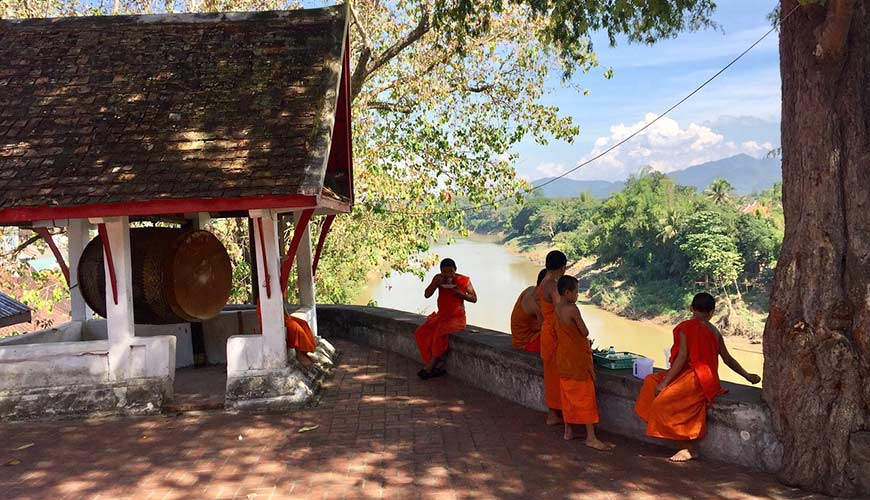
Saffron-clad monks are a common sight in Luang Prabang.
Despite the flood of money and subsequent rise in the population, the city still feels like a sleepy village frozen in time and is a centre for amazing French cuisine, as well as local style Lao food.
Beyond the city there are excellent trekking opportunities to caves brimming with religious significance, stunning waterfalls and meandering mountain paths. There are also ample chances for kayaking, ziplining and river cruises. All of this natural splendour is ringed by green mountains covered in mist.
See and Do
By far the most imposing attraction in Luang Prabang,
Phu Si hill towers over the old quarter and Royal Palace. There are two routes to reach the top; on the northern route you can view murals from the 1800’s showing famous moments in Lao history at
Wat Pa Huak, and on the southern stands the large
Wat Siphoutthabat Thippharam as well as
Wat Thammothayalan, ringed by golden Buddhas. There is also the
Buddha footprint, which seems suspiciously large for a human footprint. All three sights on the southern route are free if you don’t continue to the top.
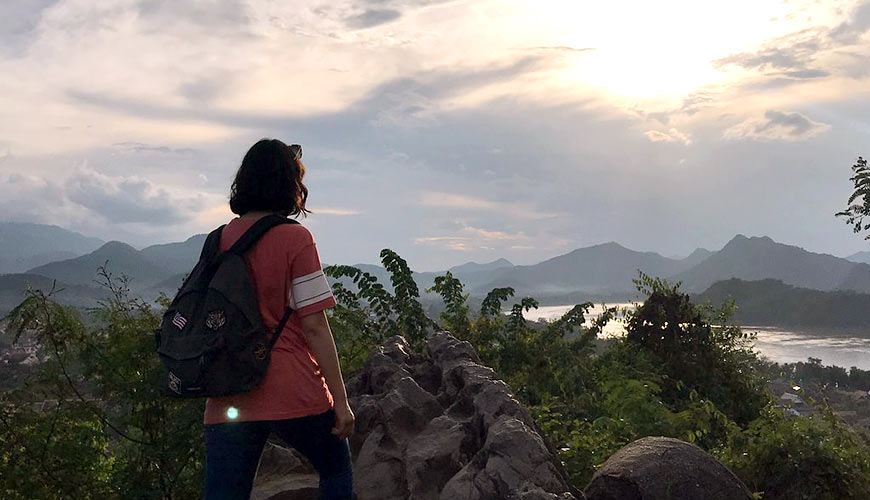
The view from Phu Si Hill is staggering.
Once you reach the top, you can enjoy the cool air, as the temple complex creates a pleasant wind tunnel effect in certain spots. While the 24 meter tall and gilded
That Chomsi stupa is gorgeous, the main reason to make the climb up is to view the
sun as it sets over Luang Prabang. For a small fee you can also release small birds here, though the morality of this is perhaps a little questionable.
While not quite as visually imposing as Phu Si, the
Royal Palace is certainly also worth a visit. The palace itself contains a myriad of tastefully decorated rooms, with some of them preserved from before the king was captured and deposed by the Pathet Lao. In the south-eastern part of the grounds, Luang Prabang’s most important monument is housed in
Wat Ho Pha Bang. The
Pha Bang, which is where the city derives its name (“Luang” meaning “Royal” and “Prabang” for the Pha Bang). The 8 meter tall gold-alloy Buddha was originally a gift from the neighbouring Khmer Empire and is highly revered in Lao society. So much so that shoes, photography and bags are not allowed in its presence. Additionally, for car enthusiasts, there is the collection of cars formerly owned by the King that is now on display on palace grounds. The collection includes five classic cars kept in good condition.
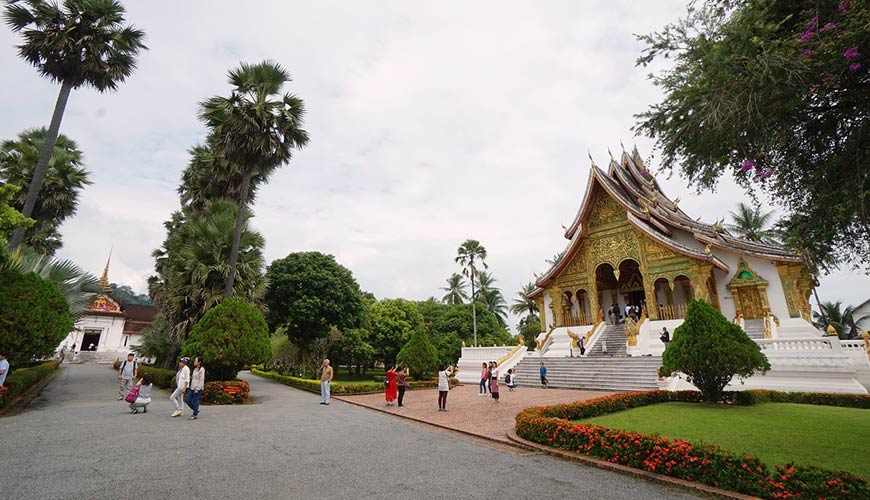
Wat Ha Pha Bang is the city’s most important monument.
For a sobering look at the continuing destruction caused by the Indochina Wars. Head to the
UXO Laos Information Centre. Here you can learn about the on-going efforts to locate and disarm unexploded ordnances (UXO) all across the country, as well as the suffering caused to the local population. Should you miss the centre here, there is another one in Phonsavan.
But of course, what Luang Prabang is truly famous for is its staggering array of temples and monasteries, and it certainly doesn’t disappoint in this department. Starting near the Royal Palace, there is
Wat Mai Suwannaphumaham, which was spared destruction in 1887 as the raiders found its wooden ordination hall with a five tiered roof simply to beautiful to defile. Slightly further out, an easy 3km bike ride away, is
Wat Pa Phon Phao, a serene meditation spot located in the forest.
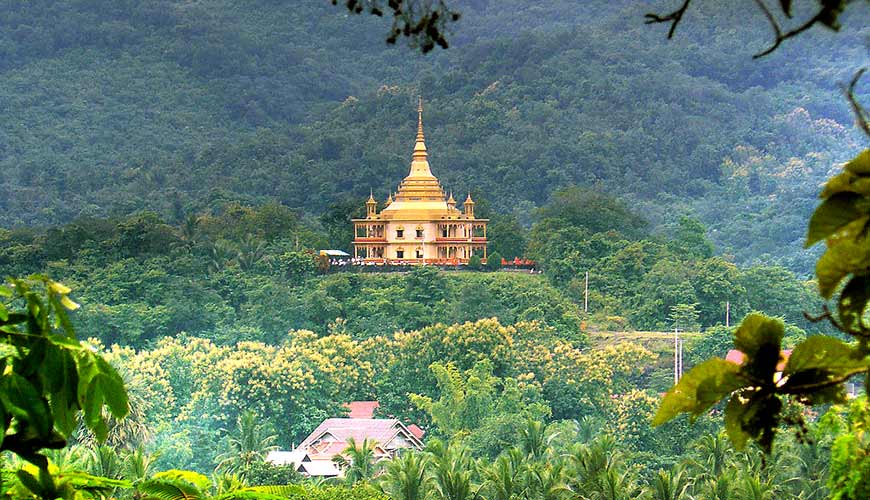
Wat Pa Phon Phao is isolated in a serene location.
On the opposite side of Phu Si hill lays
Wat Wisunarat, which has now become something of an “orphanage” for Buddha statues and ordination stones rescued from various temples in disrepair. The oldest temple in Luang Prabang,
Wat Manorom, can also be found here, where a 6 meter tall Buddha is housed. Finally, the cremation site for the old Laotian royalty is also in the area,
Wat That Luang was first established as a religious site by Ashokan monks in the 200’s AD, and looks like it would be more at home in an ancient Greek temple complex than in South East Asia.
Continuing towards the peninsula, in the Xieng Mouane Area, you have
Wat Pa Phai, featuring a detailed fresco depicting everyday Lao life during the 1800’s, and
Wat Choumkhong, which has a decidedly relaxing vibe with its red treed garden. There is also
Wat Xieng Mouane, its ceiling resplendently covered in gold naga, serving as a school for Luang Prabang’s monks to learn the crafts required for restoring and maintaining the city’s temples.
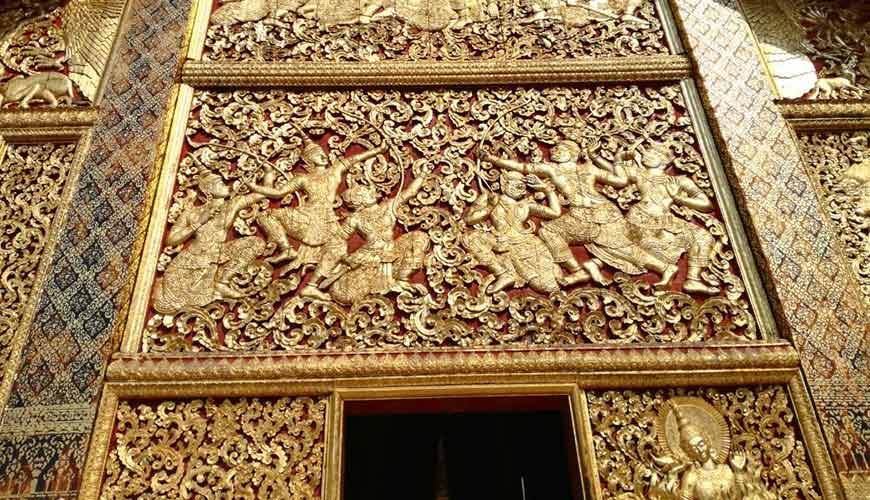
Wat Xieng Mouane is richly decorated.
Saving the best for last, the upper peninsula proper is the most renowned area in the city for monasteries and temples. Probably the most famous in the whole city,
Wat Xieng Thong, is located here. An amazing Tree of Life mosaic adorns its western wall, and two of the three nearby chapels house large Buddha statues. Those being
Hor Dai, containing a standing Buddha, and
Hor Dai Pha Sai-nyaat, nicknamed the Red Chapel by the French, housing a rare reclining Buddha.
Across the road from the customs office turned UNESCO offices, pleasantly archaic
Wat Pak Khan makes its home while
Wat Souvannakhili, looking more like a colonial mansion than a monastery, lies just up the road.
Finally,
Wat Sensoukaram is in the running for most spectacular of the temples in Luang Prabang. With its ruby-red walls covered with detailed gold overlays, it’s no wonder it reportedly took 100,000K in donations to construct, a sum that was nothing to sneeze at in 1718.
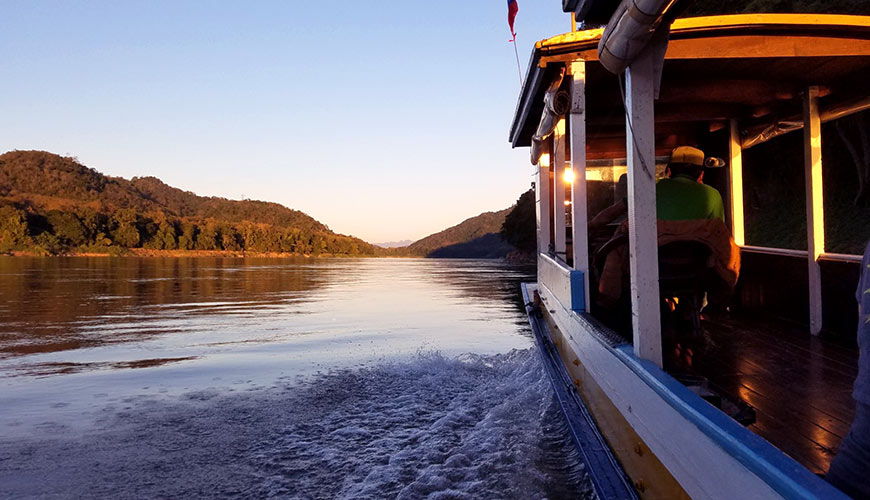
A boat-ride during sunset is highly recommended.
A short boat trip across the Mekong gives you plenty of opportunities for stunning views of the river and city beyond. The boats leave from behind the royal palace at irregular intervals, and once you’ve made the crossing your first stop will be
Wat Xieng Maen, which briefly housed the famous Pha Bang for seven days in 1867, when it was returned after 40 years in Thailand.
As you continue along the river road, the next attraction will be
Wat Chomphet. Resting on top of a small hill, you ascend 123 steps to reach the top. While the temple itself is a shell of its former self and not particularly spectacular, the little hill gives you possibly the best view of the Mekong in Luang Prabang, only rivalled by Phu Si itself.
The last thing to see on this side of the river is
Wat Longkhun, formerly a retreat for kings about to be coronated. While it’s no longer used for its former purpose, there are stunning murals of giant fish attacking sailors and fishermen, as well as
Tham Sakkalin, a 100 meter long limestone cave.
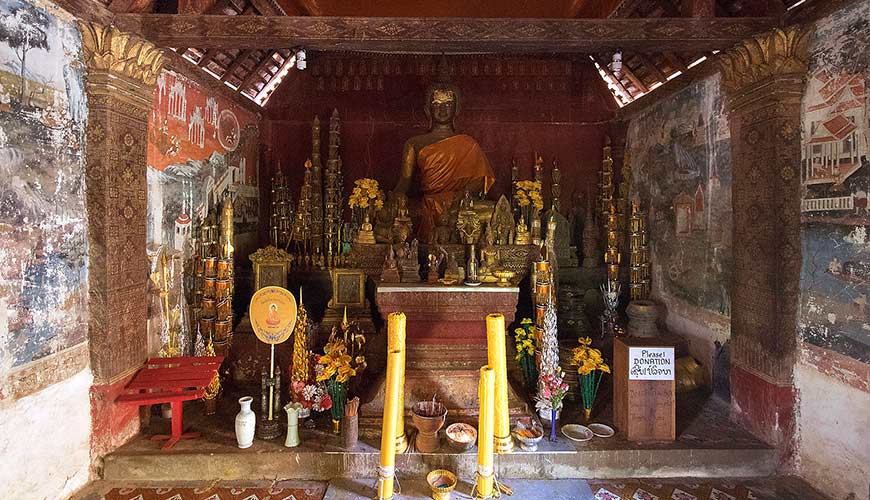
Wat Longkhun used to be a retreat for Kings.
Beyond the city itself, there’s a plethora of treks and activities you can take part in.
The Green Jungle Flight park has become very popular, sporting dozens of ziplines that you can use to glide through the treetops.
In case you haven’t seen enough temples and Buddhas yet, take a boat or kayak trip up to the
Pak Ou caves. Nestled in the limestone cliff sides that run along the shore where the Ou and Mekong Rivers reach their confluence, these two caves are home to thousands of Buddha statues, ranging from tiny at a few centimetres to humongous ones measuring as much as 6 meters.
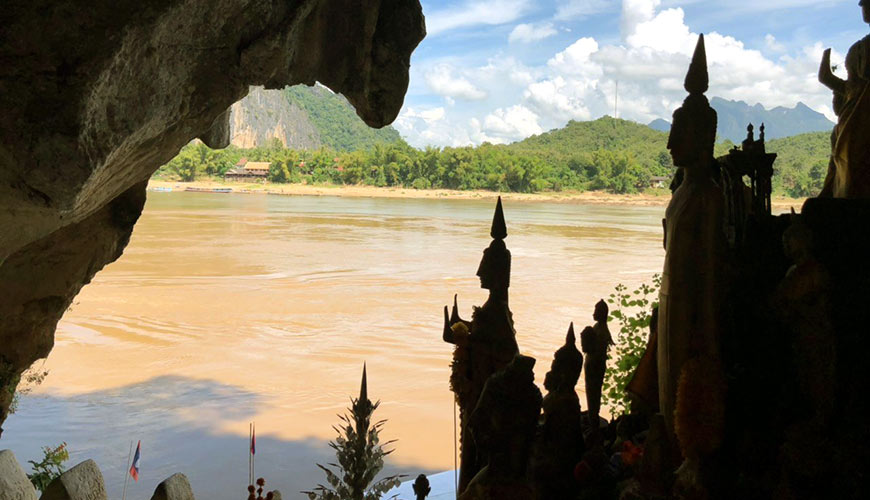
The Pak Ou Caves are filled to the brim with Buddha statues.
Considered by many to be the most beautiful sight in Laos, and indeed all of South East Asia, the
Tat Kuang Si waterfall simply cannot be missed during a visit to Luang Prabang. The water cascades down multiple tiers, stopping in serene turquoise pools that are open for swimming. If you’re up for a mildly challenging climb, or want to escape the more crowded pools, you can head all the way to the top where the crowds cooling off in the water will be substantially smaller. Aside from the falls themselves, there’s also a bear sanctuary (
Kuang Si Rescue Centre) where you can observe rescued Asiatic Wild Moon Bears. Watching the cute little bears play and rest in the open enclosures is as much a reason to go as the waterfall itself.
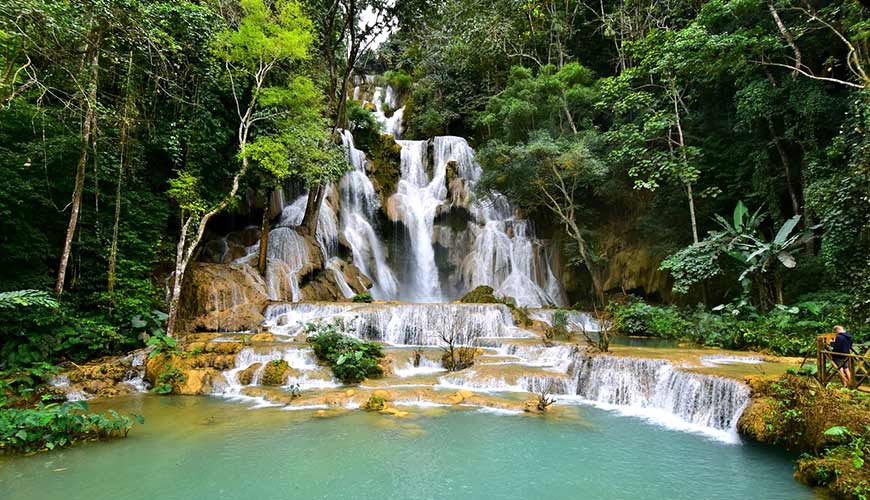
The Kuangsi falls are considered by many to be one of the most beautiful in the world.
The falls can be reached by tuk tuk or motorbike, and 300 meters before you arrive there’s a butterfly park
(Kuang Si Butterfly Park) that you can visit if you so desire.
While not possessing the giant s and pools of Tat Kuang Si,
Tat Sae waterfall is also a sight to behold. More importantly, here you can “fly” above the falls on ziplines. Bear in mind though, that unlike Tat Kuang Si, this waterfall dries up between December and August.
Culture & Arts
If you want to learn more about the various hill-tribe cultures in Laos, the
TAEC (Traditional Arts & Ethnology Centre) is a great place to start. Perfectly balanced between just enough information and not too much to overwhelm visitors, the museum also contains a café and a crafts shop.
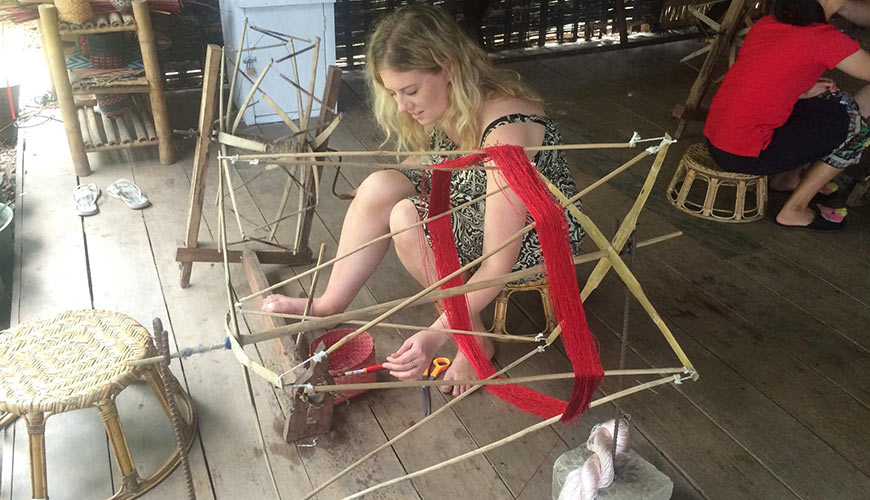
Try your hand at weaving at Ock Pop Tok Living Crafts Centre.
For more arts and crafts, the
Ock Pop Tok Living Crafts Centre offers tours every half hour to observe weavers, spinners and batik makers produce local traditional fabrics. For visitors with a brave tongue, you can also try a cup of worm-poo tea (made from silk worm pings) in the riverside café.
Furthermore, if you’re in Luang Prabang for the dry season, you can take one of the two narrow wooden bridges across the
Nam Khan. A myriad of craft boutiques are located here, as well as fantastic cafes.
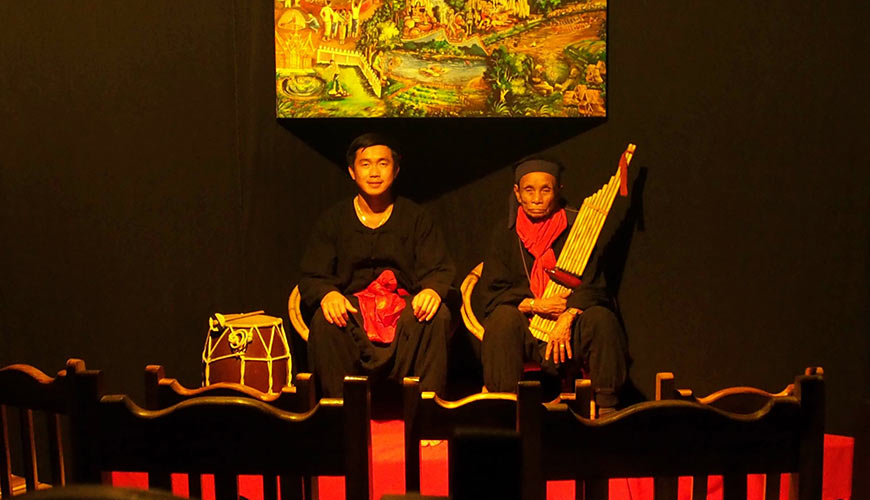
Garavek Storytelling provides a unique and authentic Laotian experience.
Perhaps the most unique and intimate cultural experience you can have in the city (and maybe all of Laos) is at
Garavek Storytelling. Here you sit in a dark room with black curtained walls as you are regaled with stories of the city’s founding and mythology by traditional Lao storytellers, accompanied by live music on classic Lao instruments.
For the photography enthusiast,
Big Tree Gallery has composite pictures displaying various scenes of rural Laos, created by photographer and film-maker Adri Berger. The gallery also contains a relaxed garden restaurant with a palm shaded terrace.
Should you wish to get up close and personal with the culture, or perhaps you wish to give something back to the city, you can head to
Big Brother Mouse. This coffee shop sells books that you can then distribute to local children, perhaps even taking the time to read with them. There are also many young adults and teenagers who come here to have conversations with travellers in an effort to improve their English. This is a fantastic opportunity to have in depth conversations with actual locals over a cup of coffee.
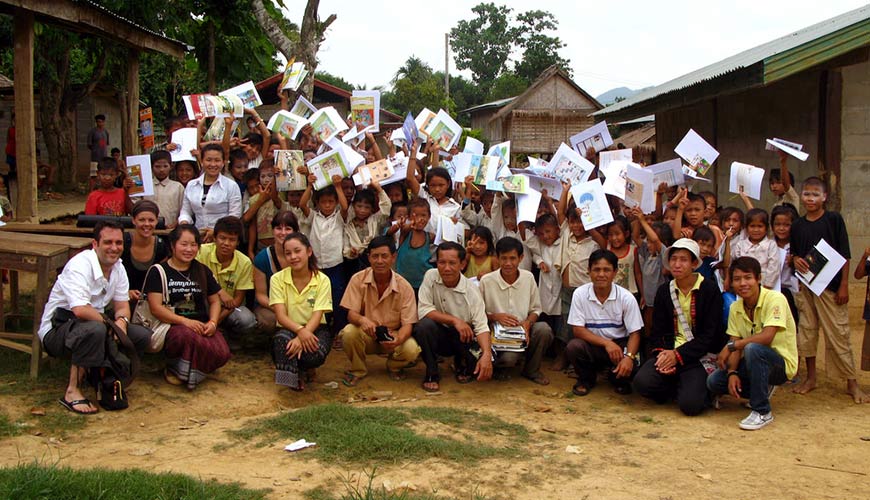
Spend some time giving back to the community at Big Brother Mouse.
When you’re on a night out, you will most likely be confronted with the idea of heading to the
Bowling Alley once the regular bars starts closing down around midnight. Outfitted with a bar, here you can continue drinking, play a few rounds of bowling or even do some archery. Many young locals will also be present, and as such presents a chance to interact with them and learn about their way of life.
Food and Drink
The best place to delight in Lao cuisine is the city’s
night market. Located in a narrow alleyway not far from Phu Si, the bustling market serves a range of well prepared Lao staples and several stalls operate in a buffet-style, letting you pick and choose what meats and vegetables you’d like. The barbequed duck here is particularly flavourful and rich. Local staples like Orlam, a stew made with meat, mushrooms, eggplant and small bitter-spicy woodchips added for flavouring, as well as Kai Baan, or Mekong riverweed, a popular local snack.
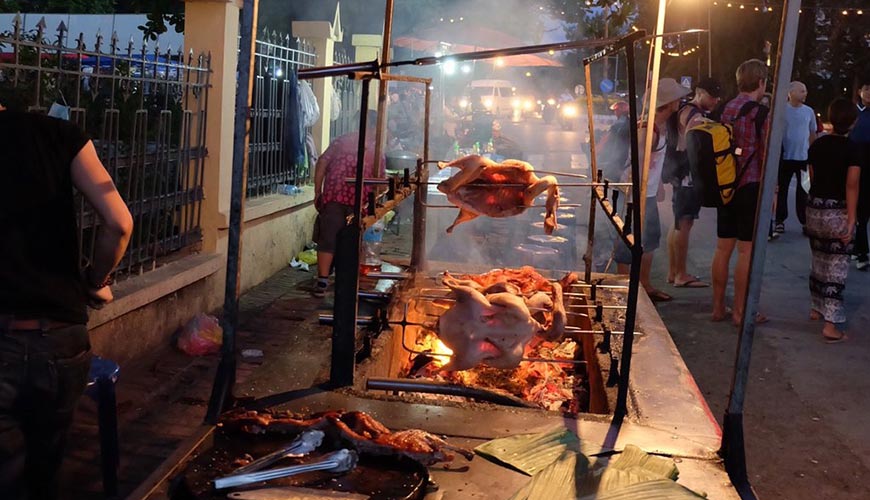
Luang Prabang street food is famous among travellers in Southeast Asia.
As the city is possibly the capital of
French cuisine outside of France itself, there are many great cafes and restaurants operating in the French fashion and serving French dishes and pastries.
Perhaps the most popular spot for the locals of the city is the
riverside barbeque joints, serving sin daat, or traditional Lao Barbeque. Here you pick out a ion of raw meats and vegetables to bring to your table, where a Lao style barbeque oven sits in the middle. Enjoy cooking your own food right at the table while the Mekong passes you by.
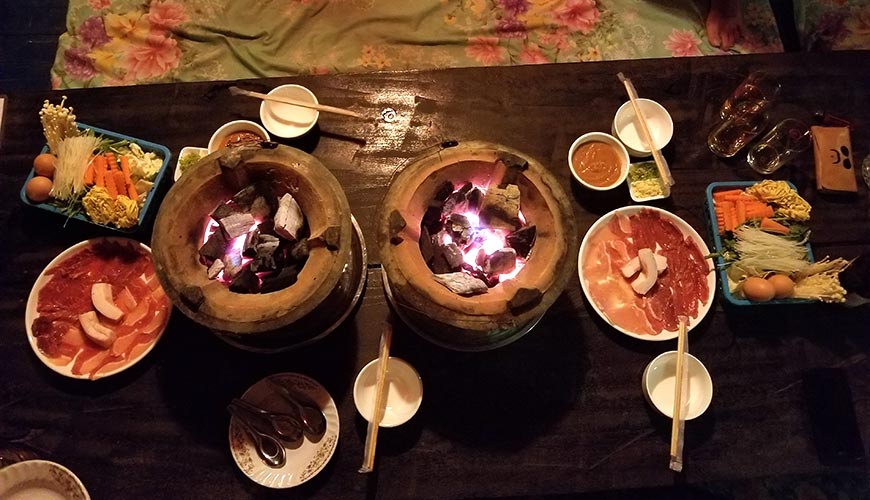
Lao style barbeque.
For a night out,
Utopia is a great place to stop. With eclectic decorations and low tables with cushions as seating, this outdoors bar is a popular spot with backpackers, who usually go here before continuing on to the aforementioned bowling alley around midnight.
For a more sophisticated drinking experience, head over to
Icon Klub. The establishment feels like a place where famous French authors from the early 1900’s would meet for drinks, and regularly features poetry slams, jam sessions and live music.
Festivals and Events
B
un Pi Mai, or Lao New Year, is the biggest event in Luang Prabang. Alternatively known as the “Water Festival” or less commonly “Songkran”, it spans three days in April and huge numbers of visitors arrive to take part in the festivities. The main event is a continuous water war where everyone is a potential target. People of all ages scurry around the streets with water guns and buckets filled to the brim, and anyone, including tourists, is fair game. Take care with your electronics during the festival, and make sure to wash out your eyes with bottled water at regular intervals, as the water is often taken straight from the Mekong River.
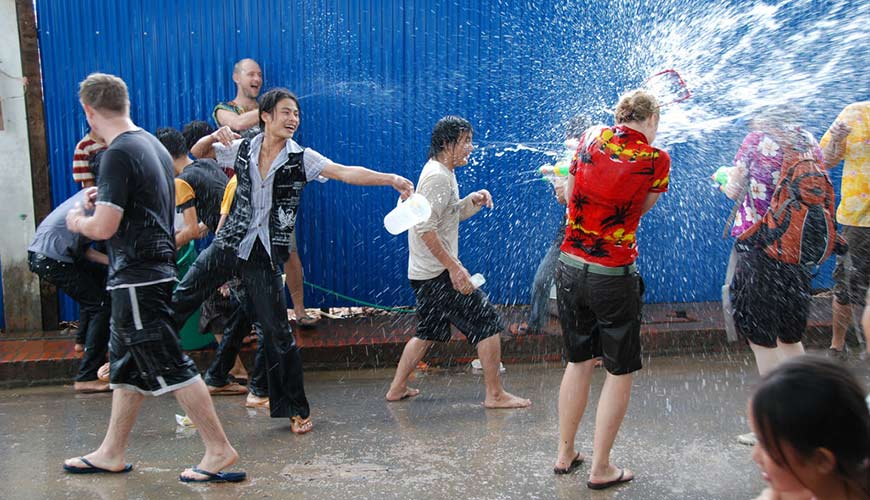
The streets explode into a 3-day long water fight for Pi Mai.
At the start of every December, the city hosts a
film festival. Here the best films from 10 South East Asian countries are shown, and entry is free of charge.
During
Bun Awk Phansa, held in September or October, boats race each other up and down the Mekong River, while faithful Buddhists send small boats made of banana leaves onto the river to carry off the bad luck of the previous year, as well as giving thanks to Mother Mekong and the guardian Naga (sea serpents) that supposedly reside deep in the river.